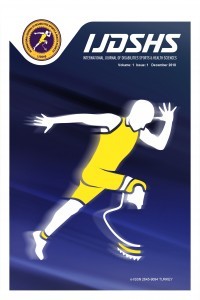The Comparison of Reaction Times in Competing Karate Athletes
Karate, Reaksiyon, Kata, Kumite, Performans
The Comparison of Reaction Times in Competing Karate Athletes
Karate, Reaction, Kata, Kumite, Performance,
___
- Beneke, R., Beyer, T., Jachner, C., Erasmus, J., & Hütler, M. (2004). Energetics of karate kumite. European journal of applied physiology, 92(4), 518-523.
- Chaabene, H. (2015). Karate Kumite: How to Optimize Performance. Physical Determinants Karate Kumite. Foster City, CA: OMICS
- Chaabene, H., Hachana, Y., Franchini, E., Mkaouer, B., & Chamari, K. (2012). Physical and physiological profile of elite karate athletes. Sports medicine, 42(10), 829-843.
- Deliu, D. (2001). Rolul Reactiei Motrice În Diagnoza, Prognoza Si Desfăsurarea Procesului De Învătare Si Perfectionare A Tehnicii Din Artele Martiale. Teză De Doctorat, Anefs
- Dilekçi, U. (2021). Karate Defense and Attack Techniques. İstanbul: Mavi Ofset Yayın ISBN: Filingeri, D.; Bianco, A.; Zangla, D.; Paoli, A.; Palma, A. (2012). Is Karate in Improving Postural Control? Sci. Martial Arts 2012, 8, 191–194.
- Fontani, G., Lodi, L., Felici, A., Migliorini, S., & Corradeschi, F. (2006). Attention in athletes of high and low experience engaged in different open skill sports. Perceptual and motor skills, 102(3), 791-805.
- Francescato, M. P., Talon, T., & Di Prampero, P. E. (1995). Energy cost and energy sources in karate. European journal of applied physiology and occupational physiology, 71(4), 355-361.
- Franchini, E.; Stanislaw, S. (2009). Testing motor fitness in karate. Arch. Budo 2009, 5, 29–34
- Fritzsche, J., & Raschka, C. (2007). Sports anthropological investigations on somatotypology of elite karateka. Anthropologischer Anzeiger; Bericht Uber die Biologisch-anthropologische Literatur, 65(3), 317-329.
- Gauchard, G. C., Lion, A., Bento, L., Perrin, P. P., & Ceyte, H. (2018). Postural control in high-level kata and kumite karatekas. Movement Sport Sciences, 100(2), 21-26.
- Giampietro, M., Pujia, A., & Bertini, I. (2003). Anthropometric features and body composition of young athletes practicing karate at a high and medium competitive level. Acta diabetologica, 40(1), s145-s148.
- Güler, M.; Ramazanoglu, (2018). N. Evaluation of Physiological Performance Parameters of Elite Karate-Kumite Athletes by the Simulated Karate Performance Test. Univ. J. Educ. Res. 2018, 6, 2238–2243.
- Harmancı, H., Karavelioğlu, M. B. (2017). Effects of different warm-up methods on repeated sprint performance. Biomedical Research, 28(17), 7540-7545.
- Imamura, H.; Yoshimura, Y.; Nishimura, S.; Nakazawa, A.T. (2002). Physiological responses during and following karate training in women. J. Sports Med. Phys. Fit. 2002, 42, 431–437.
- Karavelioglu, M. B., Harmanci, H., & Çalışkan, G. (2017). Gender differences in hand grip strength of the child athletes by using absolute, ratio and allometric scaling methods. Biomed Res, 28(4), 1533-37.
- Karavelioğlu, M. B., Başkaya, G., & Karavelioğlu, B (2021). Examination of the Effect of Different Warm-Up Protocols on Speed and Vertical Jump Performance in Child Soccer Players.
- Katić, R., Blažević, S., Krstulović, S., & Mulić, R. (2005). Morphological structures of elite karateka and their impact on technical and fighting efficiency. Collegium antropologicum, 29(1), 79-84.
- Layton, C. (1993). Reaction movement-time and sidedness in shotokan karate students. Perceptual and Motor Skills, 76(3), 765-766.
- Loturco, I., Artioli, G. G., Kobal, R., Gil, S., & Franchini, E. (2014). Predicting punching acceleration from selected strength and power variables in elite karate athletes: a multiple regression analysis. The Journal of Strength & Conditioning Research, 28(7), 1826-1832.
- Macan, J.; Bundalo-Vrbanac, D.; Romić, G. (2006). Effects of the new karate rules on the incidence and distribution of injuries. Commentary. Br. J. Sports Med. 2006, 40, 326–330.
- Molinaro, L., Taborri, J., Montecchiani, M., & Rossi, S. (2020). Assessing the effects of kata and kumite techniques on physical performance in elite karatekas. Sensors, 20(11), 3186.
- Mori, S., Ohtani, Y., & Imanaka, K. (2002). Reaction times and anticipatory skills of karate athletes. Human movement science, 21(2), 213-230.
- Nedeljkovic, A.; Mudric, M.; Cuk, I.; Jovanovic, S.; Jaric, S. (2017). Does specialization in karate affect reaction time in specific karate kumite situations? In Proceedings of the Conference of the International Society of Biomechanics in Sports, Cologne, Germany, 14–18 June 2017; pp. 404–407.
- Pieter, W., & Bercades, L. T. (2009). Somatotypes of national elite combative sport athletes. Brazilian Journal of Biomotricity, 3(1), 21-30.
- Tabben, M., Miarka, B., Chamari, K., and Beneke, R. (2018). Decisive moment: a metric to determine success in elite karate bouts. Int. J. Sports Physiol. Perform. 13, 1000–1004. doi: 10.1123/ijspp.2017-0526
- Ünveren, A., Cengiz, Ş. Ş., & Karavelioğlu, M. B. (2013). The Effect of Regular Swimming Training on Some Anthropometric Parameters and Hand Grip Strength of Children. Journal of Physical Education and Sports Sciences, 7(3), 242-247.
- Williams, A. M., & Elliott, D. (1999). Anxiety, expertise, and visual search strategy in karate. Journal of Sport and Exercise Psychology, 21(4), 362-375.
- Yayın Aralığı: Yılda 3 Sayı
- Başlangıç: 2018
- Yayıncı: Nevzat DEMİRCİ
The Effect of Role Uncertainty of Students in University Team Sports on Team Combination
Mustafa Barış SOMOĞLU, Efecan TEZCAN, Ahmet Yilmaz ALBAYRAK, Muhammed Uhud TÜRKMEN
The Effect of Sport Center Employees’ Job and Leisure Satisfaction on Quality of Life
Yetkin Utku KAMUK, Zafer DOĞRU
Fikret SEÇEN, Fethi ARSLAN, Mehmet Akif ZİYAGİL
Üstün TÜRKER, Mustafa Barış SOMOĞLU, Efecan TEZCAN, Mine KOÇ
Evaluation of FMS Scores of Competitive CrossFit Athletes by Gender
